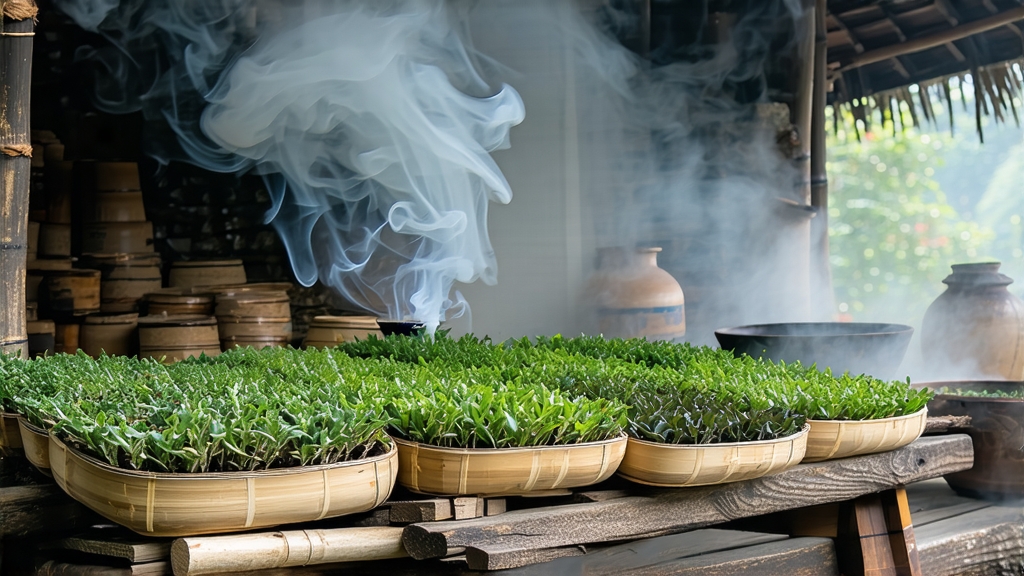
Long before Assam, Ceylon, or Earl Grey entered the English lexicon, the words “bohea” and “souchong” were whispered across the docks of Canton and the drawing rooms of London. They referred to one singular tea that sailed out of the Min River estuary in the early seventeenth century and rewrote the global beverage map: Lapsang Souchong, the original black tea. Today, when drinkers think of Chinese black tea they may picture malty Yunnan gold tips or honeyed Keemun, yet it is Lapsang Souchong—born in the precipitous Wuyi Mountains of northern Fujian—that holds the double honor of being both progenitor and iconoclast, the first fully oxidized leaf humanity ever tasted and the only one famously finished over smoldering pine.
Origin & Myth
Local legend claims the smoke-drying technique was an accident of war. In 1646, Qing troops reportedly quartered themselves in Tongmu village during the late-Ming turmoil. To dry the leaf quickly before the soldiers requisitioned it, farmers rushed the final firing stage by burning fresh pine branches in the withering loft. The resulting tea, perfumed with resin and campfire, fetched extravagant prices from the Dutch and British factors who believed the flavor “a marvel of the Orient.” Whether myth or marketing, the story underscores a truth: necessity mothered an innovation that became signature.
Terroir: The National Nature Reserve
Tongmu and the three adjacent hamlets—Mashu, Guadun, and Lian’ge—sit inside the Wuyi Mountain National Park, a UNESCO mixed heritage site where subtropical evergreens shroud granite cliffs in perpetual cloud. Day-night temperature swings of 15 °C slow the growth of the small-leaf tea bushes (cultivar Xiaozhong), concentrating amino acids and volatile aromatics. The forest floor exhales humidity that condenses into mist, shielding tender buds from direct sun and encouraging the floral precursor compounds that later balance the smoke. Because the reserve bans outside tea leaf and restricts pesticide use, every kilo of authentic Zhengshan Xiaozhong (the protected-origin name for Lapsang Souchong) is hand-picked within a 56 km² core zone—an area smaller than Manhattan.
Two Faces of the Same Leaf
International markets usually know only the smoky version, yet connoisseurs distinguish two styles:
- Traditional Lapsang Souchong (pine-smoked): Leaves are withered over soft pine fires, then pan-fired, rolled, oxidized 90–100 %, and finally re-dried on bamboo trays suspended above a pinewood hearth. The smoke bonds with leaf moisture, locking in a phenolic sweetness reminiscent of single-malt whisky and cured bacon.
- Unsmoked Xiaozhong (recent “innovation” since 2005): Responding to domestic preference for cleaner profiles, Tongmu artisans now also produce a non-smoked batch dried with hot air and charcoal embers. The cup shows dried longan, honey, and a cooling alpine note, proving that the raw material itself carries innate elegance.
Craft: A Day in the Loft
Harvest begins at dawn in late April when the standard is one bud with two leaves, about 3.5 cm long. After three hours of solar withering, the leaf is carried into the qinglou, a three-storey wooden house whose upper chambers are lined with woven rattan mats. Here, pine logs—preferably 30-year-old Masson pine—are lit in shallow pits. The fresh smoke drifts upward, never flaming, maintained at 40–45 °C. Artisans turn the leaf every twenty minutes for eight hours; the smell evolves from cut grass to peach skin to pipe tobacco. Oxidation follows in cloth-lined barrels where the leaf piles are massaged by hand until mahogany edges appear. A final 90-second bake at 80 °C sets the aroma. The entire process must finish the same day, making Lapsang Souchong one of the most labor-intensive black teas on earth.
Grading the Smoke
Not all smoke is equal. Top-grade (Jipin) uses only the tender spring bud, yielding a liquor the color of sherry with a lingering lychee sweetness behind the ember. First grade (Yipin) incorporates the first leaf, balancing malt and resin. Second grade (Erpin) allows larger leaf and heavier smoke, traditionally exported to Russia for samovar brewing cut